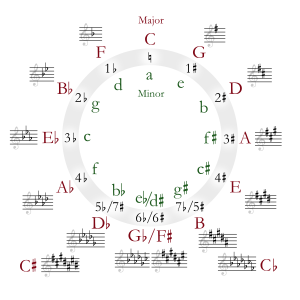G-flat major
 | |
| Relative key | E♭ minor |
|---|---|
| Parallel key | G♭ minor enharmonic: F♯ minor |
| Dominant key | D♭ major |
| Subdominant | C♭ major enharmonic: B major |
| Enharmonic | F♯ major |
| Component pitches | |
| G♭, A♭, B♭, C♭, D♭, E♭, F | |
G-flat major is a major scale based on G-flat, consisting of the pitches G♭, A♭, B♭, C♭, D♭, E♭, and F. Its key signature has six flats.
Its relative minor is E-flat minor. Its parallel minor is G-flat minor, usually replaced by F-sharp minor, since G-flat minor's two double-flats make it generally impractical to use.
Its direct enharmonic equivalent is F-sharp major, a key signature with six sharps.

Rarely chosen as the main key for orchestral works, G-flat major is more often used as a main key for piano works, such as the impromptus of Chopin and Schubert. It is the predominant key of Maurice Ravel's Introduction and Allegro for harp, flute, clarinet and string quartet.
A striking use of G-flat major can be found in the love duet "Tu l'as dit" that concludes the fourth act of Giacomo Meyerbeer's opera Les Huguenots.
Austrian composer Gustav Mahler was fond of using G-flat major in key passages of his symphonies; examples include: The choral entry during the finale of his Second Symphony,[1] during the first movement of his Third Symphony,[2] the modulatory section of the Adagietto from his Fifth Symphony,[3] and during the Rondo-Finale of his Seventh Symphony.[4] Mahler's Tenth Symphony was composed in the enharmonic key of F-sharp major.
This key is more often found in piano music, as the use of all five black keys allows an easier conformity to the player's hands, despite the numerous accidentals. German composer Franz Schubert chose this key for his third impromptu from his first collection of impromptus (1827). The Polish composer Frédéric Chopin wrote two études in the key of G-flat major: Étude Op. 10, No. 5 "Black Key" and Étude Op. 25, No. 9 "Butterfly". French composer Claude Debussy used this key for one of his most popular compositions, "La fille aux cheveux de lin," his eighth prélude from his Préludes, Book I (1909-1910).
References
- ^ Mahler, Gustav. Symphonies Nos. 1 and 2 in Full Score, Dover, ISBN 0-486-25473-9 (1987) p. 354.
- ^ Mahler, Gustav. Symphonies Nos. 3 and 4 in Full Score, Dover, ISBN 0-486-26166-2 (1989), p. 53.
- ^ Mahler, Gustav. Symphonies Nos. 5 and 6 in Full Score, Dover, ISBN 0-486-26888-8 (1991), p. 175.
- ^ Mahler, Gustav. Symphony No. 7 in Full Score, Dover, ISBN 0-486-27339-3 (1992), p. 223.

